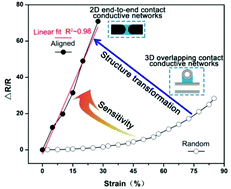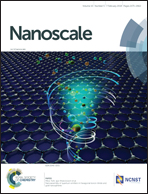2D end-to-end carbon nanotube conductive networks in polymer nanocomposites: a conceptual design to dramatically enhance the sensitivities of strain sensors†
Abstract
New generation wearable devices require mechanically compliant strain sensors with a high sensitivity in a full detecting range. Herein, novel 2D end-to-end contact conductive networks of multi-walled carbon nanotubes (MWCNTs) were designed and realized in an ethylene-α-octene block copolymer (OBC) matrix. The prepared strain sensor showed a high gauge factor (GF) of 248 even at a small strain (5%) and a linear resistance response throughout the whole strain range. The sensors also exhibited very good stretchability up to 300% and high cycling durability. This novel design solved the intrinsic problem of sensors based on carbon nanotube bundles, i.e., a long sliding phase before the disconnection of CNTs in a cost-effective and scalable way. This study rationalizes the 2D end-to-end contact concept to improve the sensitivity of the existing sensors and has great potential to be used in a wide variety of polymer based sensors.



 Please wait while we load your content...
Please wait while we load your content...